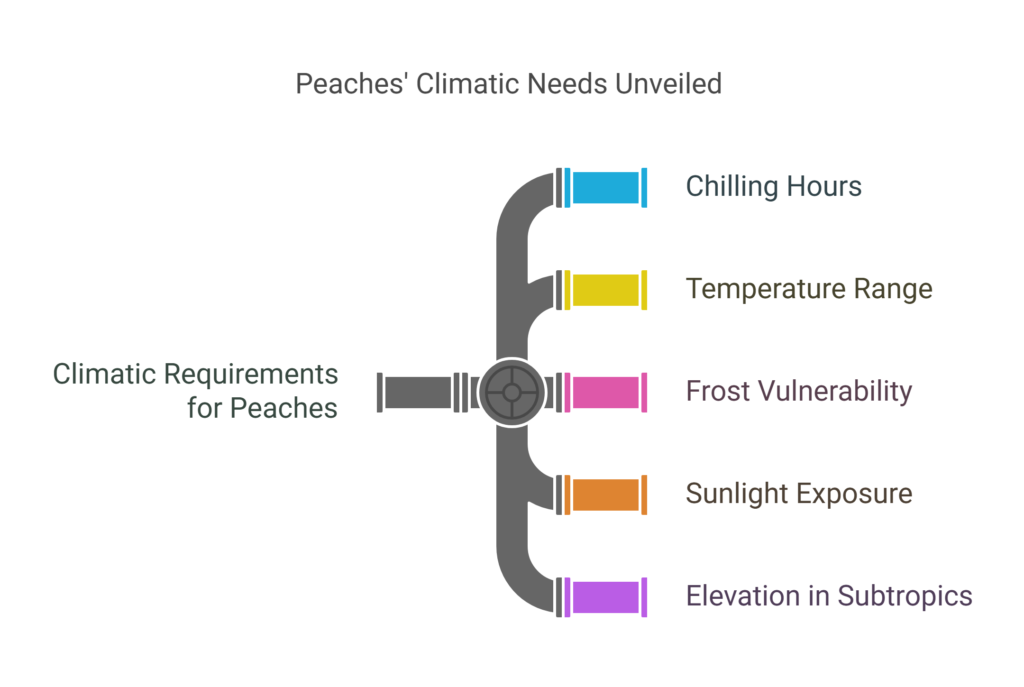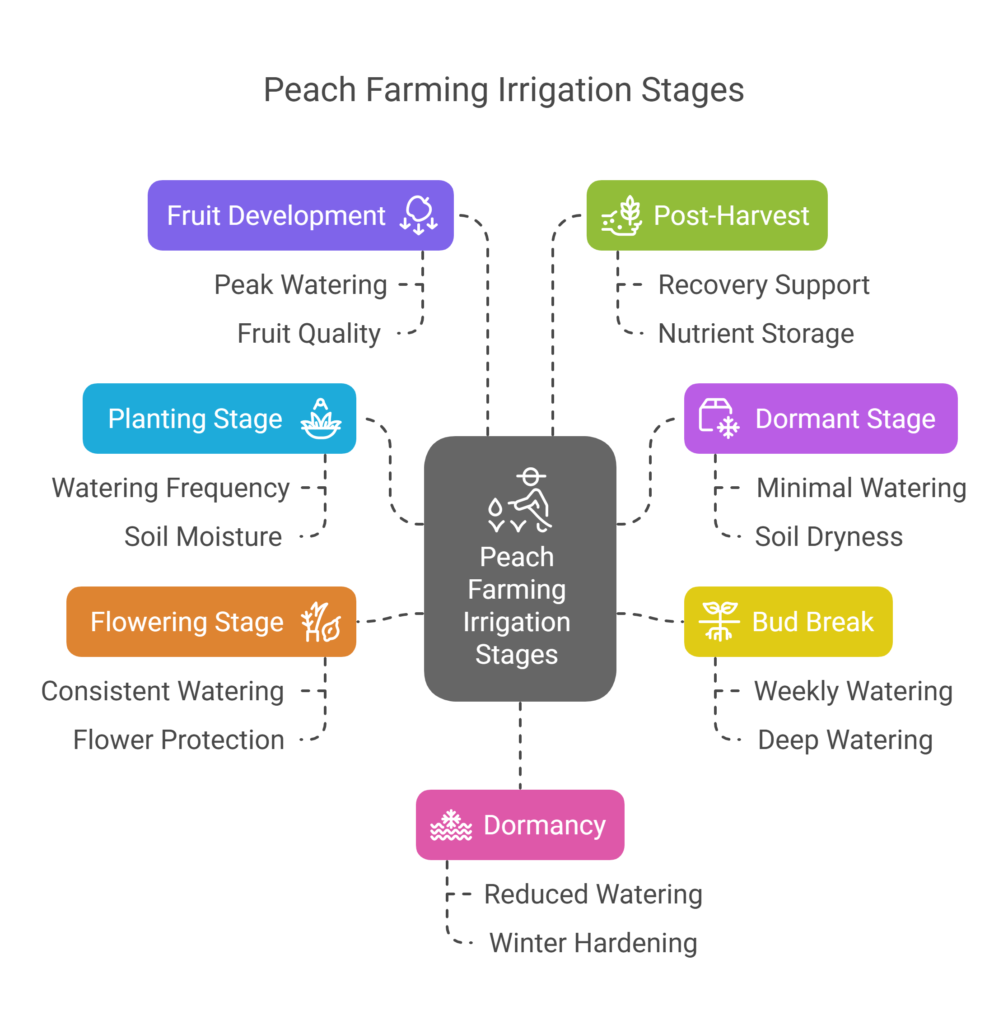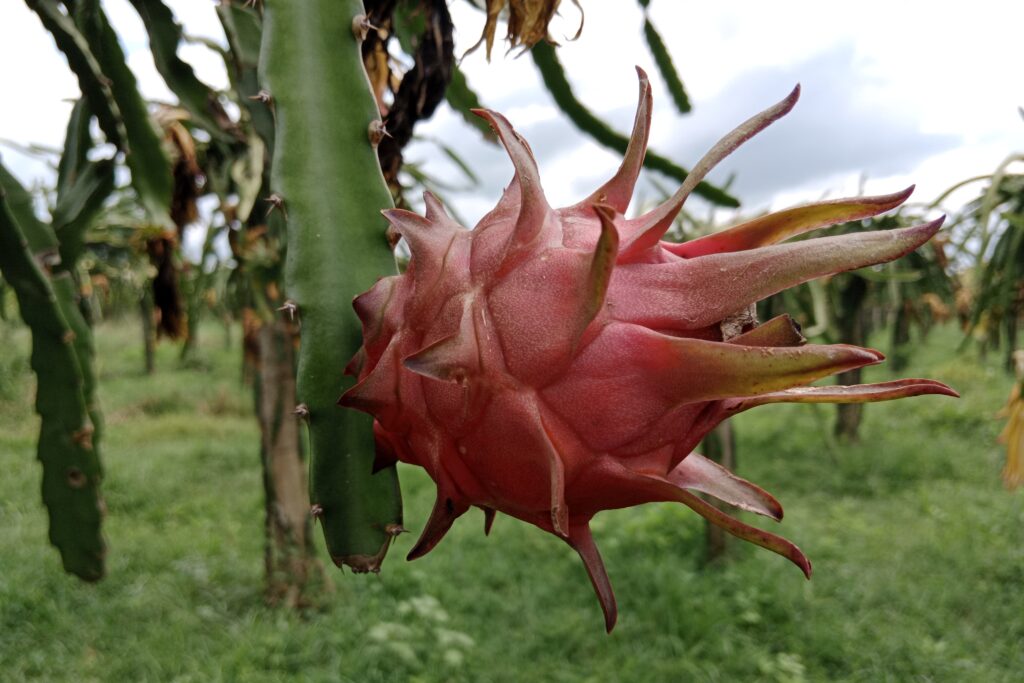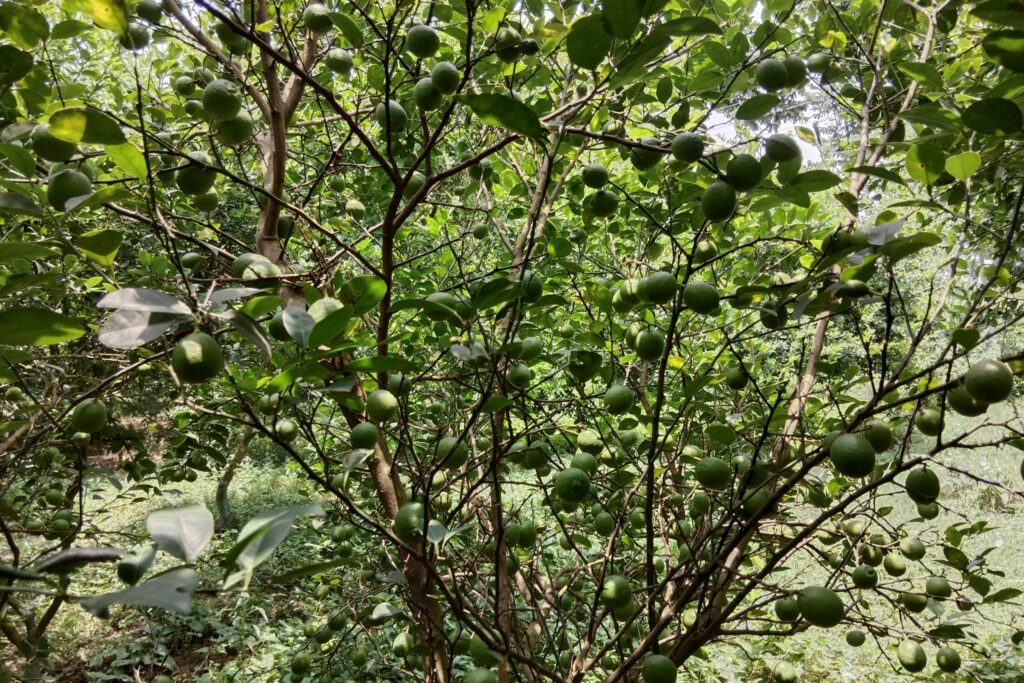Peach Farming
A detailed 15-year study of peach farming profit per acre reveals dramatic differences between cultivation methods. The low-density system (112 trees/acre) shows modest peach farming profit per acre of NRs. 1,890,000 cumulative incomes. In other side, high-density peach farming profit per acre reaches NRs. 4,330,000 delivering NRs. 1.47 million net profit per acre despite higher initial investments. When analyzing annual peach farming profit per acre, the high-density model grows from NRs. 30,000 in year two to NRs. 1.3 million during peak production, clearly demonstrating its superior profit potential per acre.
However, maximizing peach farming profit per acre requires three key factors: rigorous crop management to maintain yields, stable market prices between NRs. 100-200/kg (with organic premium potential), and optimized labor for intensive pruning – all investments that significantly enhance long-term profitability per acre in commercial peach cultivation.
Land Preparation
Successful peach farming begins with thorough land preparation to ensure optimal root development and maximum yield potential, starting with complete clearance of existing vegetation and debris, followed by deep plowing (30-40 cm depth) to loosen soil and enhance aeration, with subsequent harrowing to break clods and level the field, while incorporating 10-20 tons/ha of well-decomposed farmyard manure (FYM) during final preparation to enrich soil fertility, and critically implementing proper drainage systems through raised beds or gentle slopes to prevent waterlogging – a particular vulnerability of peach trees that can significantly impact plant health and productivity if not addressed during this foundational stage.
Soil Type
For a healthy peach crop, a minimum of one meter of soil depth is required to support the large root system and guarantee the best possible nutrient uptake and anchoring. Peach trees do best in sandy loam to loamy soils that drain well and have a high organic matter content; a pH of 6.0 to 7.5 is optimum. Avoid heavy clay or saline soils as they impede the growth of trees and the development of roots.
Climatic Requirements

As temperate-zone fruits, peaches require specific climatic conditions for optimal growth, including 300–1000 chilling hours below 7°C (depending on cultivar) to break dormancy, thrive in an ideal temperature range of 20–30°C during the growing season, and are particularly vulnerable to frost damage during flowering; they demand full sunlight exposure for proper fruit development and in subtropical regions are typically grown at elevations between 1000–2500 meters to ensure adequate chilling requirements are met while avoiding extreme temperature fluctuations that could compromise yield quality and quantity.
Major Cultivars
Cultivar selection depends on climate and chilling requirements:
a). High Chilling Cultivars
- July Elberta
- Flordasun
- Redhaven
- J.H. Hale
- Golden Jubilee
b). Low Chilling Cultivars (for subtropical areas)
- Flordaprince
- Sharbati Safeda
- Shan-e-Punjab
- Partap
These varieties differ in fruit size, ripening time, and resistance to pests and diseases.
Planting
a). Planting Season
Peach trees should ideally be planted during the dormant season, with December-January being optimal in temperate climates, while in subtropical regions, January-February planting before bud break is recommended to ensure proper establishment and growth synchronization with seasonal changes.
b). Spacing
For optimal peach orchard management, standard spacing of 6m × 6m is recommended for traditional plantings, while high-density systems utilize tighter 6m × 1.5m spacing – both configurations are carefully designed to ensure adequate air circulation between trees, maximize sunlight penetration for fruit development, and accommodate necessary machinery movement for cultivation and harvesting operations.
c). Pit Preparation
For successful peach orchard establishment, dig 1m³ pits (1m × 1m × 1m) at least one month before planting and prepare the planting medium by thoroughly mixing topsoil with 15 kg of farmyard manure (FYM), 500 g single super phosphate, 100 g neem cake, 100 g Trichoderma viride, and 50 g biofertilizer containing nitrogen-fixing bacteria, phosphate-solubilizing bacteria (PSB), and potassium-mobilizing bacteria to create an optimal growth environment that enhances nutrient availability, promotes root development, and provides protection against soil-borne pathogens while allowing sufficient time for the amendments to properly integrate with the soil before transplanting.
d). Planting Method
Use healthy grafted saplings on compatible rootstocks (like wild peach or plum) for the best establishment. Carefully place each plant in the middle of the prepared pit, keeping the graft union 5–7 cm above the ground to avoid rootstock sprouting. Then, firmly backfill with the enriched soil mixture and water thoroughly right away to settle the soil around the roots and supply the necessary moisture for early growth.
d). Plant Count per Acre
d). Number of Plants per Acre
The number of peach plants per acre varies significantly based on planting systems, with traditional 6m × 6m spacing accommodating approximately 112 plants per acre, while high-density planting at 6m × 1.5m spacing allows for 449 plants per acre, offering growers flexible options to optimize land use based on their production goals, available resources, and preferred orchard management practices.
Intercropping
Intercropping is an effective practice during the initial years of peach orchard establishment before canopy closure, with suitable intercrops including legumes (beans, peas), vegetables (okra, onions), and fodder crops that complement rather than compete with young peach trees, providing additional farm income and natural weed suppression while avoiding water-intensive or nutrient-demanding crops that could hinder the main crop’s growth and development.
Irrigation
Proper irrigation is crucial for peach trees to ensure healthy growth, optimal fruit production, and tree longevity. Below is a detailed breakdown of irrigation requirements at different growth stages, based on the information provided:

a). Planting Stage (Newly Planted Trees)
It is advised to water young peach trees two to three times a week for the first few weeks, then once a week if there is no rain, as they need constant moisture to form roots. The best way to promote deep root growth without overwatering, which can cause root rot, is to use drip irrigation or a moderate soak.
b). Dormant Stage (Winter – Before Bud Break)
During the dormant stage (winter, before bud break), peach trees require minimal irrigation unless experiencing extreme drought; watering every 3–4 weeks (only if the soil is very dry) is sufficient to prevent excessive dehydration while avoiding unnecessary moisture that could harm the tree during its rest period.
c). Bud Break (Early Spring – Growth Resumes)
During the bud break stage (early spring, as growth resumes), irrigation becomes critical as the tree exits dormancy and develops new shoots—young trees should be watered weekly (if no rain) while mature trees require deep watering every 10–15 days to ensure healthy leaf and shoot development, setting the foundation for robust seasonal growth.
d). Flowering Stage (Spring – Pollination & Fruit Set)
Consistent irrigation is essential during the flowering stage (spring, pollination, and fruit set) because water stress can drastically reduce fruit set. While mature trees require watering every 7–10 days (more frequently in hot and dry conditions), young trees need weekly watering to maintain moist (but not waterlogged) soil. Care must be taken to avoid wetting the flowers, and drip irrigation is the best way to prevent fungal diseases while guaranteeing optimal water delivery.
e). Fruit Development (Summer – Fruit Growth & Maturation)
The fruit development stage (summer – fruit growth & maturation) demands peak irrigation as peaches enlarge, requiring weekly deep watering for young trees and every 7-10 days for mature trees (adjusted for rainfall) to prevent fruit drop and ensure plump, juicy peaches, though growers should gradually reduce watering near harvest to minimize fruit splitting risks while maintaining quality.
f). Post-Harvest (Late Summer – Fall – Tree Recovery)
During the post-harvest stage (late summer to fall), peach trees require careful irrigation to support recovery and nutrient storage for the next season—young trees should be watered weekly during dry periods while mature trees need irrigation every 10-15 days until dormancy, ensuring proper root development and bud formation for the following year’s crop without overwatering that might delay winter hardening.
g). Dormancy (Winter – Reduced Water Needs)
During dormancy (winter), peach trees require minimal irrigation—water only during extreme drought conditions when the soil becomes very dry (approximately every 3–4 weeks), as excessive moisture during this period can compromise root health and interfere with the tree’s natural winter hardening process.
Fertilizer and Manure
Proper fertilization is crucial for healthy growth, high yields, and quality fruit production in peach orchards. Below is a stage-wise fertilizer guide covering the entire lifespan of peach trees.
a) Pre-Planting (Soil Preparation)
Two to three weeks before planting, enrich each pit with 10 kg of well-rotted FYM (Farm Yard Manure) or compost, along with mineral fertilizers, including:
- 500 g of Single Super Phosphate (SSP)
- 100 g of Trichoderma viridae (for disease suppression)
- 50 g of biofertilizer (containing nitrogen-fixing bacteria, PSB, and Potassium Mobilizing Bacteria)
Additionally, adjust soil pH to 6.0-7.0 (peaches prefer slightly acidic soil) using lime for acidic soils or gypsum for alkaline soils to create optimal growing conditions for peach saplings.
b) Planting Stage (0-1 Year)
For the first three months after planting, avoid chemical fertilizers to prevent root burning—only provide light watering. After this period, fertilization begins with:
- 50g Nitrogen (N) (urea or CAN)
- 30g Phosphorus (P) as SSP
- 30g Potassium (K) as MOP
Divide these nutrients into two equal doses, applied every three months to support healthy young tree development.
c) Young Trees (1-4 Years – Vegetative Growth)
Peach trees grow vigorously in their early years, requiring increasing nutrient inputs:
| Year | N (g/tree) | P (g/tree) | K (g/tree) | Frequency |
| Year 1 | 50 – 70 | 30 – 50 | 30 – 50 | 3 split doses (March, July, October) |
| Year 2 | 80 – 100 | 50 – 70 | 50 – 70 | 3 split doses (March, July, October) |
| Year 3 | 120 – 150 | 70 – 100 | 70 – 100 | 3 split doses (March, July, October) |
| Year 4 | 150 – 200 | 100 – 120 | 100 – 120 | 3 split doses (March, July, October) |
d) Mature Trees (5+ Years – Fruiting Stage)
Once peach trees begin fruiting, adjust fertilization to support fruit development:
| Nutrient | Dosage (g/tree/year) | Application Timing |
| Nitrogen (N) | 400 – 700 | 50% at flowering, 50% after fruit set |
| Phosphorus (P) | 200 – 400 | Full dose before flowering |
| Potassium (K) | 400 – 700 | 50% at fruit set, 50% before harvest |
| Micronutrients (Zn, B, Fe) | As needed | Foliar spray during growth stages |
Weed Control
Effective weed control in peach orchards can be achieved through manual weeding or shallow hoeing around tree basins to avoid root damage, supplemented by organic or plastic mulching to suppress weed growth and conserve soil moisture, while carefully selected herbicides like glyphosate may be used judiciously with proper application techniques to prevent tree injury and maintain orchard health.
Pest and Disease Management
Major Pests
a). Peach fruit fly
Native to South and Southeast Asia, the peach fruit fly (Bactrocera zonata) is a very damaging pest that infests a variety of commercially significant fruits, such as citrus, guavas, peaches, and mangoes. Because of its quick reproduction, wide host range, and climate adaptation, this invasive species is a serious danger to agriculture.
The larvae of female flies feed on the pulp of ripening fruit after laying their eggs beneath its skin, resulting in premature fruit drop and unmarketable output. To stop its spread and reduce financial losses in impacted areas, effective management techniques like pheromone traps, bait sprays, and quarantine regulations are crucial.
Management
- Manage peach fruit fly, use methyl eugenol-based traps to monitor and mass-trap male flies, and apply protein bait sprays mixed with insecticides to target females.
b). Peach leaf curl Aphids
Damage symptoms include aphid colonization of young shoots, buds, grafts, and young plants; nymphs and adults suck sap from leaves, shoots, and fruits, causing terminal shoots to wilt and leaves to become yellow. The most damaging attacks occur in the spring.
Management
- Spray insecticide imidacloprid 1ml / litre water.
- Natural enemies of leaf curling aphid:Scymnus, Chilomenes sexmaculatus, Chrysoperla zastrow sillemi, coccinellids, mantids, parasitic wasps, ladybird beetles, and predatory mites.
c). Apricot brown scale
Direct damage occurs when nymphs insert their stylets during feeding, leading to premature leaf drop and twig dieback; high populations can kill the host, while severe infestations may cause shoot or branch dieback. Large scale populations also promote sooty mold growth due to excessive honeydew excretion.
Management
- Natural enemies of apricot brown scale:Predators include ladybugs, lacewings, and mites.
d). San Jose Scale
When feeding on twigs, branches, and fruit, San Jose scales may inject salivary toxins, which can cause harm. If severe infestations on the bark are not treated, they may damage twigs, branches, or even entire trees in addition to causing gumming. Small twigs or diseased fruit frequently develop a distinctive red halo-like discolouration surrounding the bug, which makes the fruit ugly and prompts culling.
Management
- To control scale insects, select nursery stock free from infestation and fumigate with HCN gas or methyl bromide.
- Apply systemic insecticides such as phosalone (0.05%), fenitrothion (0.05%), or methyl demeton (0.025%) for effective management.
- Promote biological control by releasing natural predators like Chilocorus nigritus(coccinellid beetle) and the parasitoid Encarsia perniosi to suppress scale populations sustainably.
Major Diseases
a). Leaf curl (Taphrina deformans)
Caused by the fungus Taphrina deformans, peach leaf curl damages fruit, leaves, and flowers, which may weaken the tree and limit fruit production. Puckering, curling, and thickening, infected leaves frequently turn crimson before turning yellow and dropping off too soon. Although fruit may occasionally develop elevated, wrinkled spots as a result of the illness, these signs are typically mild and frequently ignored.
Management
- Fungicides, such as chlorothalonil or copper-based options like copper oxychloride, provide effective control when applied before bud break.
b). Powdery mildew
This disease, caused by Podosphaera pannosa, primarily affects green peach fruit but also impacts leaves and shoots, appearing as a powdery white coating. Infected young fruit develops white spots that enlarge, turn brown, and appear rusty, though symptoms usually fade as the fruit matures.
Management
- Spray with sulfur-based fungicides
c). Brown rot
Fruit rot begins as a small, circular brown spot that gradually enlarges, eventually causing the entire fruit to decay. Infected fruits dry out and harden, becoming mummified on the tree. The fungus persists through winter by surviving on these fruit mummies and twig cankers.
Management
- Remove infected fruits.
- Spray with fungicide carbendazim 2ml / liter water.
Harvesting
As non-climacteric fruits that do not ripen significantly after harvest, peaches must be picked at optimal maturity when their ground color changes from green to creamy, yellow, or red (depending on cultivar), accompanied by slight softening and development of a characteristic fruity aroma; careful manual harvesting is essential to prevent bruising, with well-managed orchards typically yielding 30–40 kg per tree annually, translating to approximately 8–12 tons per hectare depending on variety, tree age, and cultivation practices.
Cost of Investment for Peach Farming Per Acre
| S.N. | Categories | Low Density (112 plants/acre) | High Density (449 plants/acre) | Remarks |
| 1 | Land Preparation (Plowing, Leveling) | 40,000 | 60,000 | High-density requires deeper soil work. |
| 2 | Peach Saplings | 33,600 | 134,700 | 4x more saplings in high-density. |
| 3 | Fertilizers & Manure | 40,000 | 157,150 | Higher nutrient demand due to crowding. |
| 4 | Drip Irrigation Setup | 100,000 | 250,000 | Precision watering critical for high-density. |
| 5 | Labor (Planting + Maintenance) | 30,000 | 50,000 | More intensive pruning/thinning. |
| 6 | Pest & Disease Control | 30,000 | 60,000 | Higher risk of fungal issues in dense plots. |
| 7 | Miscellaneous (Equipment, Mulch) | 30,000 | 50,000 | Mulch reduces weed competition. |
| Total Initial Investment | 303,600 | 761,850 | High-density costs ~2.5x more upfront. |
Annual Maintenance Cost
From the second year onward, peach orchards require an annual maintenance investment of NRs. 100,000–200,000 per acre to cover essential operational expenses including skilled labor for pruning and harvesting, balanced fertilizer applications, comprehensive pest and disease management programs, and regular irrigation system maintenance – these critical expenditures ensure optimal tree health, consistent fruit production, and sustained orchard productivity throughout the production cycle.
Income from Peach Farming Per Acre
| Year | Yield (Low Density) | Yield (High Density) | Rate/kg (NRs.) | Income (Low Density) | Income (High Density) |
| 2nd Year | 100 kg | 300 kg | 100 | 10,000 | 30,000 |
| 3rd Year | 800 kg | 2,000 kg | 100 | 80,000 | 200,000 |
| 4th–6th Year | 3,000 kg | 7,500 kg | 100 | 300,000 | 750,000 |
| 7th–10th Year | 6,000 kg | 13,000 kg | 100 | 600,000 | 1,300,000 |
| 11th–15th Year | 4,000 kg | 9,000 kg | 150 | 600,000 | 1,350,000 |
| 15+ Year | 1,500 kg | 3,500 kg | 200 | 300,000 | 700,000 |
Analysis of Peach Farming Profit Per Acre
Profitability Analysis
a). Cumulative Income Over 15 Years
Over a 15-year cycle, peach cultivation under low-density planting (112 trees/acre) generates cumulative revenues of approximately NRs. 1,890,000, while high-density planting (449 trees/acre) delivers significantly greater returns at NRs. 4,330,000 – demonstrating 2.3 times higher profitability due to substantially increased yield potential per acre.
With high-density systems achieving annual revenues between NRs. 30,000 in year two to NRs. 1.3 million during peak production years (7-10), ultimately yielding a net profit of NRs. 1.47 million after accounting for the higher initial investment (NRs. 761,850) and annual maintenance costs, whereas low-density systems fail to break even, incurring a net loss of NRs. 513,600 despite lower setup costs (NRs. 303,600), primarily due to insufficient production volume to offset ongoing expenses.
b). Net Profit Analysis
After accounting for both initial investments and 15 years of maintenance costs, low-density peach planting (112 trees/acre) results in a net loss of NRs. 513,600, with total income of NRs. 1,890,000 failing to offset the combined costs of NRs. 2,403,600 (initial NRs. 303,600 + annual NRs. 150,000 × 14 years), while high-density planting (449 trees/acre) proves profitable, generating NRs. 4,330,000 in total income against NRs. 2,861,850 in costs (initial NRs. 761,850 + same annual maintenance), yielding a substantial net profit of NRs. 1,468,150—demonstrating that despite requiring 2.5× higher upfront investment, the high-density system’s superior productivity delivers a viable return over the long term.
High-density peach planting proves significantly more profitable, delivering NRs. 1.4 million+ net profit over 15 years despite higher initial costs, while low-density systems struggle to break even due to inadequate yields that can’t offset comparable maintenance expenses – success hinges on three critical factors: (1) maintaining consistent yields through rigorous pest/water control in densely planted orchards, (2) sustaining market prices at NRs. 100-200/kg (with potential premium margins for organic produce), and (3) optimizing labor efficiency to manage increased pruning and thinning demands characteristic of high-density systems, which while costly, ultimately justify their higher manpower requirements through superior returns.
Reference
Kanwar, J.S. and Singh, H. (2004). SCOPE OF HIGH DENSITY PLANTINGS OF PEACH IN THE SUBTROPICS OF INDIA. Acta Hortic. 662, 221-224
DOI: 10.17660/ActaHortic.2004.662.31


